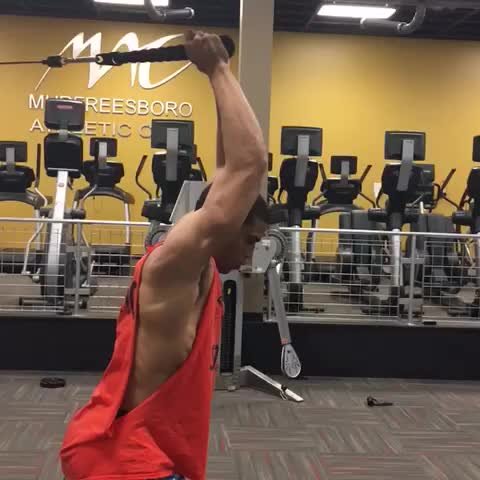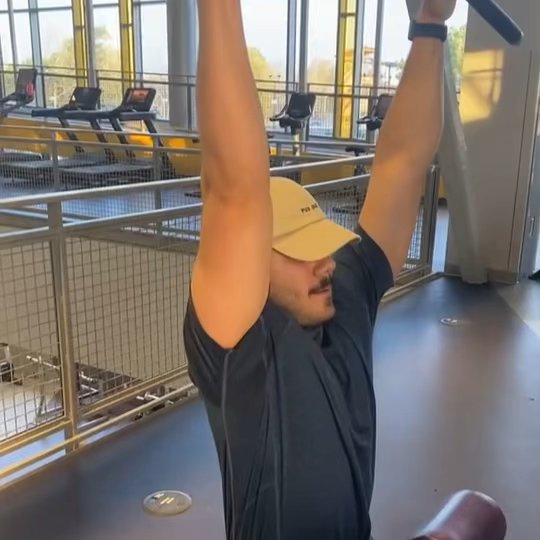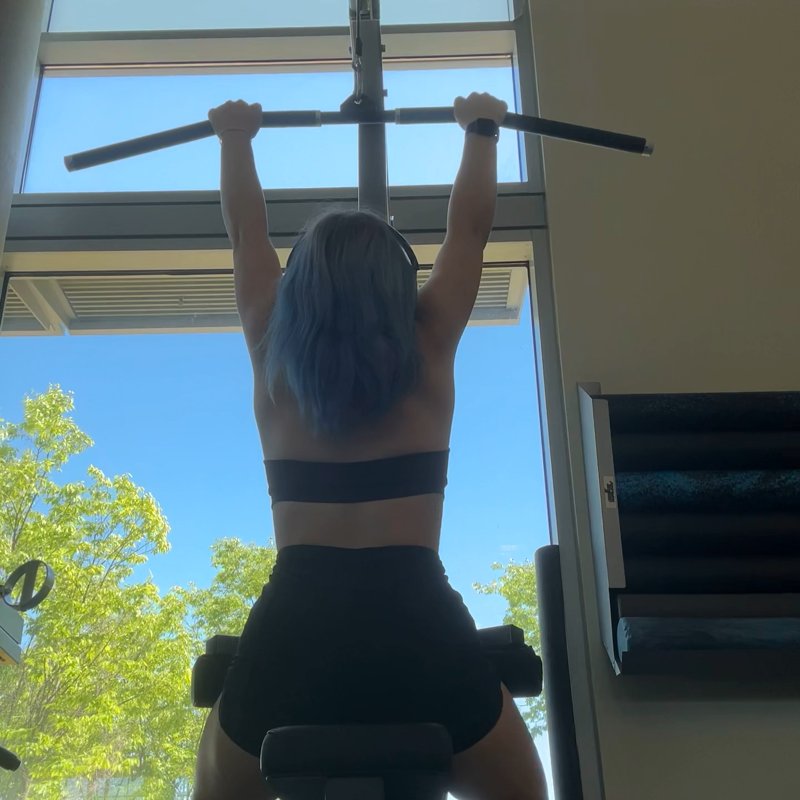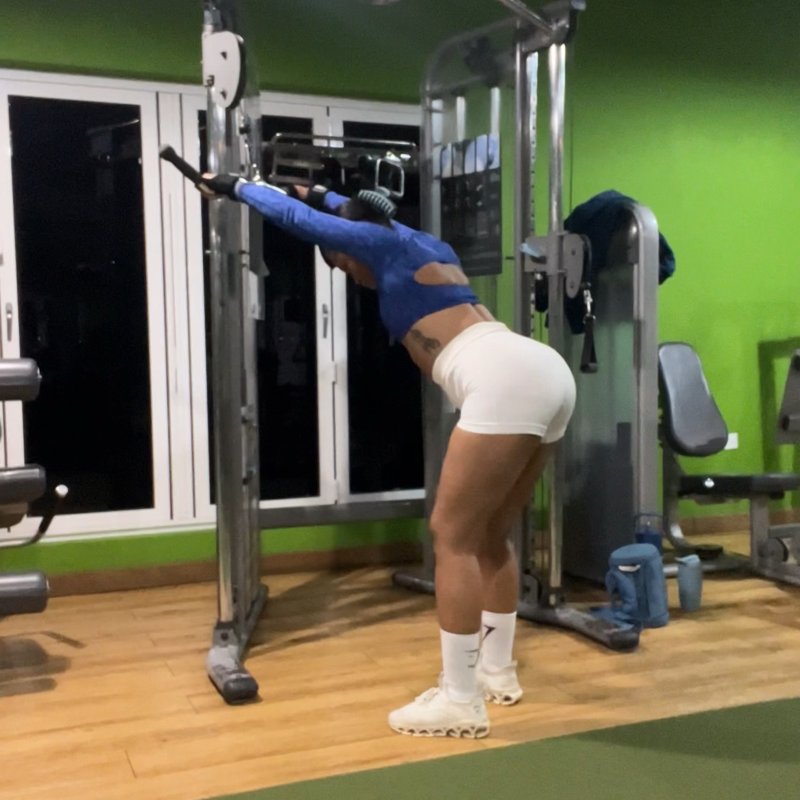Cable Lat Pullover: The Ultimate Guide
The Cable Lat Pullover is an isolation exercise that primarily targets the latissimus dorsi and serratus anterior muscles using a constant tension cable setup to create width in the back and improve upper body aesthetics.

Quick Facts
Key Benefit
Lat and serratus development with constant tension
Primary Muscles
Lats
Secondary Muscles
Abdominals, Pectoralis Major, Pectoralis Minor, Posterior Deltoids, Rhomboids, Triceps
Equipment
cable machine
Difficulty
Intermediate
Type
Isolation
In This Guide
Ready to master the Cable Lat Pullover?
Track your progress, see improvements over time, and build strength consistently.
Download GravitusThe Cable Lat Pullover is a specialized isolation exercise that effectively targets the latissimus dorsi—the large, fan-shaped muscles that create back width and contribute significantly to the coveted V-taper physique. While similar in basic mechanics to its dumbbell and machine counterparts, the cable variation offers unique benefits through its constant tension and customizable resistance curve. This movement works the lats through a different plane of motion compared to rows and pulldowns, focusing on shoulder extension rather than adduction or depression. The unique motion activates not only the lats but also significantly engages the serratus anterior (the "boxer's muscle" along the ribcage), parts of the chest, and the triceps long head. What distinguishes the cable version from other pullover variations is the consistent resistance throughout the entire range of motion. Unlike free weights where resistance peaks at certain points due to gravity's influence, the cable maintains tension on the working muscles from start to finish, potentially enhancing the training stimulus. Whether your goal is to develop wider lats, improve thoracic mobility, enhance breathing capacity, or simply add an effective isolation movement to your back training, the Cable Lat Pullover delivers targeted stimulation through a unique movement pattern that complements traditional pulling exercises.
Benefits of Cable Lat Pullovers
The cable variation offers several distinct advantages compared to other pullover variations.
Constant Tension
The cable provides consistent resistance throughout the entire range of motion, maintaining stimulus on the working muscles from start to finish.
Adjustable Resistance Profile
By positioning yourself differently relative to the cable, you can modify how the resistance feels at different points in the movement.
Serratus Activation
The movement significantly engages the serratus anterior, a muscle often underdeveloped but important for shoulder health and aesthetic appeal.
Thoracic Extension
The arm position and movement pattern promote thoracic spine extension, potentially improving posture and upper back mobility.
Joint-Friendly Alternative
Many lifters find the cable version easier on the shoulders compared to heavy dumbbell pullovers, particularly when using a rope attachment.
Lat Isolation
The single-joint movement allows for focused lat work without significant involvement of the biceps that occurs in many compound pulling movements.
Proper Form & Technique
Setup
- Attach a rope handle or straight bar to a high cable pulley.
- Position yourself standing with your back to the cable machine, approximately 1-2 feet away from the tower.
- Grasp the rope or handle with both hands, using an overhand grip (palms facing down) or neutral grip depending on the attachment.
- Take 1-2 steps forward to create tension on the cable.
- Establish a firm stance with feet shoulder-width apart and knees slightly bent.
- Begin with your arms extended upward and slightly behind your head, elbows slightly bent.
- Maintain a slight forward lean from the hips with chest up and shoulders pulled back.
- Engage your core to stabilize your torso throughout the movement.
Movement
- Keeping your arms relatively straight with a slight bend in the elbows, initiate the movement by engaging your lats.
- Pull the attachment forward and downward in an arcing motion, maintaining the same elbow bend throughout.
- Focus on using your lats to drive the movement rather than your arms or shoulders.
- Continue the arc until your hands reach approximately thigh level, with arms extended in front of your body.
- Hold the contracted position briefly, focusing on the lat and serratus contraction.
- Slowly return to the starting position, resisting the weight in a controlled manner.
- Allow your arms to move back behind your head to achieve a full stretch in the lats at the top position.
- Maintain core engagement and proper posture throughout the entire movement.
- Repeat for the desired number of repetitions, focusing on quality over quantity.
Key Form Tips
Elbow Position
Maintain a slight, consistent bend in your elbows throughout the movement—neither completely straight nor excessively bent.
Movement Path
Focus on moving in a smooth arcing motion, as if your arms are following the outline of a large circle.
Lat Engagement
Concentrate on feeling your lats drive the movement, rather than relying primarily on arm or shoulder strength.
Torso Position
Keep your chest up and maintain a slight forward lean throughout the exercise to optimize lat recruitment.
Range of Motion
Achieve a full stretch at the top and complete contraction at the bottom for maximum muscle stimulation.
Muscles Worked
Primary Muscles
- lats: The large, fan-shaped muscles on the sides of the back that create width and are the primary target of this exercise.
Secondary Muscles
- pectoralis major: The lower portion of the chest muscle assists during the initial phase of the pullover movement.
- pectoralis minor: A smaller chest muscle that assists in stabilizing the shoulder during the pullover movement.
- triceps: The long head of the triceps crosses the shoulder joint and works during the extension and flexion of the shoulder during the movement.
- teres major: Often called the "little lat," this muscle works closely with the latissimus dorsi during the pulling motion.
- posterior deltoids: The rear portion of the shoulder muscle assists during the pullover movement, particularly during the initial phase.
- Rhomboids: The muscles between the shoulder blades assist in stabilizing the scapulae during the movement.
- abdominals: The abdominals and lower back muscles work isometrically to maintain proper torso position throughout the exercise.
Common Mistakes and How to Fix Them
Excessive Elbow Bending
Bending the elbows significantly during the movement turns it into more of a triceps pushdown than a lat pullover. Maintain a relatively consistent, slight bend in your elbows throughout the entire range of motion. The goal is to keep the same degree of elbow bend from start to finish, with the movement occurring at the shoulder joint rather than the elbow. If you notice your elbows flexing significantly as you pull down, consciously focus on keeping them in a fixed, slightly bent position. Using a lighter weight can help reinforce proper form until the movement pattern becomes natural. Some lifters find attaching a visual or mental cue to "lock" the elbow angle helps maintain proper positioning.
Insufficient Range of Motion
Not achieving full stretch at the top or complete contraction at the bottom limits the exercise's effectiveness. Allow your arms to extend behind your head at the starting position, feeling a significant stretch in your lats. At the bottom position, continue the arc until your hands reach approximately thigh level with arms extended in front of your body. If mobility limitations prevent a full range of motion, work on thoracic extension and shoulder flexibility separately. For some lifters, a slight adjustment in stance or distance from the cable tower can facilitate a more complete range. Remember that the lat pullover is particularly valuable for its ability to provide a full stretch and contraction—don't limit these benefits by cutting the movement short.
Using Momentum
Swinging or using body movement to create momentum reduces the work done by the target muscles. Control the movement throughout the entire range of motion, both during the downward pull and the return phase. Implement a deliberate tempo—perhaps 2 seconds down, 1-second squeeze at the bottom, 3 seconds up—to eliminate momentum. Focus on feeling the lats doing the work rather than simply moving the attachment from point A to point B. If maintaining control is challenging, reduce the weight until you can perform the movement strictly. Quality of muscle contraction is far more important than the amount of weight used for this isolation exercise.
Poor Torso Position
Excessive arching of the lower back or hunching forward during the movement. Maintain a slight forward lean from the hips with chest up and shoulders pulled back throughout the exercise. Engage your core to stabilize your torso, preventing excessive spinal movement during the pullover. If maintaining proper position is difficult, strengthening your core with specific exercises can help provide better stabilization. Some lifters find that a split stance (one foot forward, one back) provides better balance and makes it easier to maintain proper torso positioning, particularly when using heavier weights.
Incorrect Cable Height
Using a cable that's too low or too high can alter the exercise mechanics and reduce effectiveness. The cable pulley should be set high, typically at or slightly above head height, to create the optimal pulling angle for lat activation. If the pulley is too low, the angle will shift emphasis away from the lats and more toward the chest or triceps. If it's positioned too high, it may create excessive strain at the shoulder joint. Most commercial cable stations have adjustable pulleys—take the time to find the optimal height for your individual body proportions. If your gym has limited adjustment options, you can modify your distance from the machine or your stance to create a better angle of pull.
Hand Position Too Close or Too Wide
Hand placement that's non-optimal for your body structure can reduce lat engagement. For most people, an approximately shoulder-width grip with hands either neutral (using a rope) or pronated (using a bar) works best. If hands are too close together, you may limit the range of motion and full contraction potential. If they're too wide, you might shift emphasis away from the lats toward the chest or reduce the ability to achieve a full stretch. Experiment with different grip widths to find what creates the strongest lat contraction for your individual body structure. Many lifters find that a rope attachment allows the most natural hand positioning throughout the movement, as it permits some rotation from the neutral position at the top to a slightly more pronated position at the bottom, following the natural mechanics of the shoulder joint.
Exercise Variations
Equipment Variations
-
Rope Lat Pullover
Using a rope handle which allows for a neutral grip and natural rotation of the wrists throughout the movement.
-
Straight Bar Cable Lat Pullover
Employing a straight bar attachment with an overhand grip, which some find creates stronger lat activation but may be less comfortable for the wrists.
-

V-Bar Lat Pullover
Utilizing a V-shaped attachment that provides a narrow neutral grip position for a slightly different feel and hand placement.
-
D-Handle Lat Pullover
Performing the movement with a single D-handle grasped with both hands, creating a close grip variation that some find allows for better focus.
Position Variations
-
Kneeling Cable Lat Pullover
Executing the movement from a kneeling position to provide greater stability and potentially better lat isolation with reduced lower body involvement.
-
Seated Cable Lat Pullover
Performing the exercise while seated on a bench or stability ball to provide a different angle of pull and stable base.
-
Single Arm Cable Lat Pullover
Using one arm at a time to address potential muscle imbalances and increase core anti-rotation demands.
-

Incline Bench Cable Lat Pullover
Lying on an incline bench facing away from the cable machine to provide back support and create a different pulling angle.
Technical Variations
-

Cable Pullover with Pause
Adding a deliberate 2-3 second isometric hold at the point of maximum contraction to increase time under tension.
-

Eccentric-Focused Cable Pullover
Emphasizing the negative portion with a 4-5 second controlled return to the starting position to increase muscle damage and growth stimulus.
-

Low-to-High Cable Pullover
Setting the cable to a low position and pulling from low to high, effectively reversing the traditional movement to target the lats from a different angle.
-

Cable Pullover to Row Combination
Combining the pullover motion with a rowing movement, pulling first down in the arc, then bending the elbows to pull to the torso for a compound movement.
Frequently Asked Questions
Neither version is universally "better"—they each offer distinct advantages that make them complementary rather than competitive. Cable pullovers provide constant tension throughout the entire range of motion, whereas dumbbell pullovers have a more variable resistance curve with peak tension when the dumbbell is parallel to the floor. This constant tension from cables can create a different stimulus and potentially greater time under tension. The cable version also allows for more customization of the resistance profile by adjusting your position relative to the machine, and often enables a more complete range of motion for many lifters. Dumbbell pullovers, however, offer their own benefits including greater accessibility (requiring minimal equipment), more freedom of movement, and potentially greater core engagement due to the stabilization required on a bench. For most trainees, incorporating both variations in a training program provides the most comprehensive development. You might rotate between them across different training sessions or training blocks to take advantage of their unique benefits. The "best" choice ultimately depends on your specific goals, equipment availability, comfort, and individual biomechanics.
The appropriate weight for cable lat pullovers depends on your training experience, current strength level, and specific goals. Unlike compound exercises where maximum loading is often primary, the pullover is an isolation movement where technique and muscle activation should take precedence over absolute weight. For most trainees focused on back development, select a weight that allows you to complete 8-12 controlled repetitions with proper form, feeling significant lat engagement throughout the movement. Signs that you've chosen an appropriate weight include: (1) ability to maintain a consistent, slight elbow bend throughout the movement, (2) feeling the work primarily in your lats rather than arms or shoulders, (3) controlling both the positive and negative portions of the exercise, and (4) reaching temporary muscle failure or very close to it by the end of the set. If you find yourself using excessive momentum, significantly bending the elbows during the pull, or unable to feel the lats working, the weight is likely too heavy. Remember that the pullover is a specialized movement designed to create a specific stimulus for the lats—focus on the quality of contraction rather than the quantity of weight used.
For most trainees, cable pullovers are best included in back-focused training sessions, as the primary muscles targeted are the latissimus dorsi and serratus anterior. While the movement does engage the chest to some degree (particularly the lower sternal fibers), the lat involvement is typically more significant with proper execution. In a body-part split routine, include pullovers on your back or pull day. In an upper/lower split, they fit well in upper body sessions with an emphasis on pulling movements. For push/pull/legs splits, they belong in the pull workout. That said, some bodybuilders with extensive experience occasionally use pullovers as a bridge exercise between chest and back workouts, particularly when training with very high volume and frequency. If you're specifically trying to develop the serratus anterior (which contributes to both chest aesthetics and shoulder function), pullovers could conceivably be included in either workout. However, for most lifters—especially those with limited training experience—simplicity is best: categorize pullovers as a back exercise and program them accordingly for clear organization and proper recovery management.
Most people respond well to training each major muscle group 2-3 times per week with sufficient recovery between sessions. For cable lat pullovers specifically, incorporating them 1-2 times weekly is typically optimal for most trainees. If following a body part split, you might perform this exercise on your designated back or pull day once per week. With an upper/lower split, they could be included in one of your two weekly upper body sessions. For push/pull/legs or other three-day splits, they might appear in one of your two weekly pull workouts. Consider your overall back training volume—the cable pullover is typically a complementary exercise to primary movements like rows and pulldowns, not a replacement for them. The specialized nature of the pullover makes it valuable as an accessory movement, but it shouldn't typically replace compound pulling exercises entirely. For most lifters, performing 3-4 working sets of cable pullovers 1-2 times weekly provides sufficient stimulus without overtraining. More advanced lifters might occasionally increase frequency to 3 times weekly during specialization phases specifically designed to improve back width, but this approach should be time-limited and monitored for recovery.
Your elbows should maintain a slight, consistent bend throughout the entire range of motion—neither completely straight nor significantly bent. This subtle bend (approximately 10-20 degrees) serves several important purposes: First, it reduces stress on the elbow joint itself. Second, it helps maintain tension on the lats rather than transferring it to the triceps. Third, it allows for a more natural shoulder movement pattern. The key is keeping the same degree of elbow bend from start to finish, with movement occurring primarily at the shoulder joint. If you keep your arms completely straight, you may place excessive stress on the elbow joints and potentially reduce lat activation. Conversely, if you bend your elbows significantly or change the angle during the movement, you transform the exercise into more of a triceps pushdown or compound pulling motion, reducing its effectiveness as a lat isolation exercise. Some experimentation with the exact degree of elbow bend may be beneficial to find what creates the strongest lat contraction for your individual biomechanics, but the principle of maintaining consistent elbow positioning throughout the movement remains constant regardless of the specific angle chosen.
Video Demonstrations
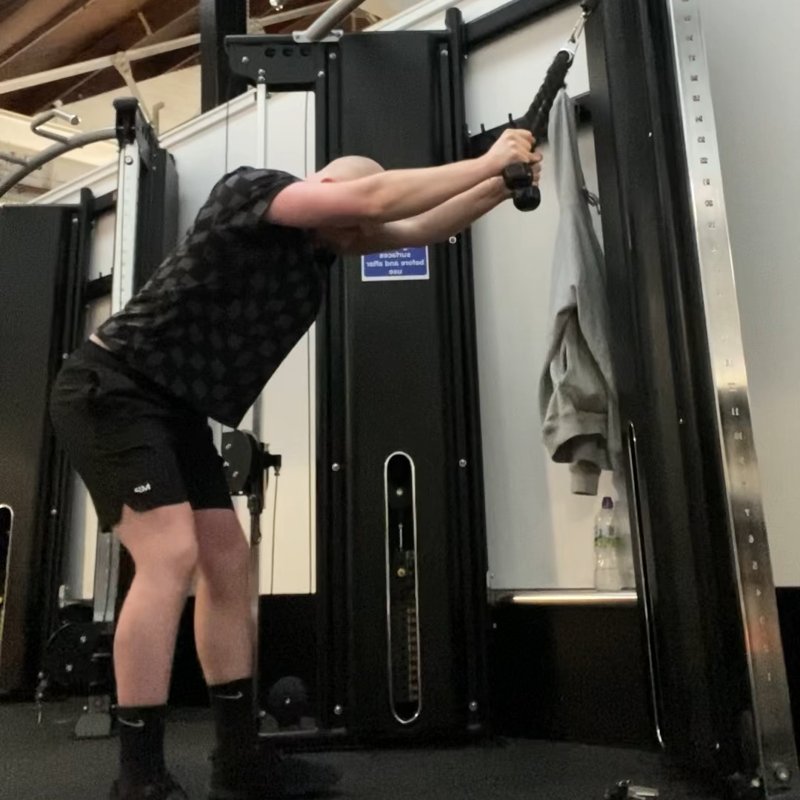
Log in to watch video demonstrations
Login to WatchTips from the Community
-

An exercise that has slowly lost popularity because people have learned just how useful the deadlifts, vertical and horizontal pulling are but this is a great “finisher” on your pull days. I’ve found success with this on higher reps 10+
Track your progress with Gravitus
Download Gravitus to log your workouts, track your progress, and join a community of fitness enthusiasts.

Helpful Resources
One Rep Max Calculator
Find your one rep max for any exercise without maximal testing. Essential for developing effective strength training programs.
Calculate 1RMWorkout Programs
Follow structured workout programs created by fitness professionals to maximize your strength and muscle gains.
View Programs